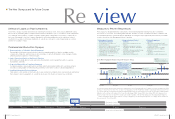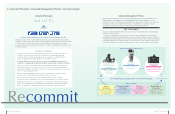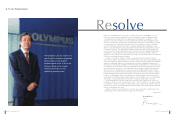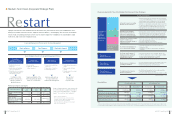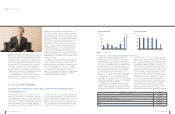Olympus 2013 Annual Report Download - page 4
Download and view the complete annual report
Please find page 4 of the 2013 Olympus annual report below. You can navigate through the pages in the report by either clicking on the pages listed below, or by using the keyword search tool below to find specific information within the annual report.
2 OLYMPUS Annual Report 2013
February–June 2013January 2013July–December 2012
Implementation of improvement measures
Internal system operational period Inspection period
June 2012May 2012
Internal system development period
Development of regulations
Development of system
January 2013
Submission of
written afrmation
on the internal
control system
to TSE.
1. Overconcentration of Authority in Senior Management Establishment of Independent Committees
We have established the Nominating Committee and the Compensation Committee, which are comprised primarily
of highly independent outside officers, effectively separating authority related to corporate officer nomination and
compensation from management.
Under the guidance of these committees, the Company has transformed significantly. At the suggestion of the
Compensation Committee, we introduced a stock option system to reflect our shareholders’ perspective into
compensation. Also, based on the nomination of the Nominating Committee, we appointed a female outside director.
2. Lack of Supervisory Function of the Board of Directors Clear Segregation of Business Execution
and Supervisory Functions
The Board of Directors now consists of a majority of outside directors, and these and other corporate officers are
appointed based on the nominations of the Nominating Committee, ensuring complete independence from management.
This system also allows for clear segregation of the business execution function, handled by inside directors and
executive officers, and the decision-making function and supervisory function of the Board of Directors. Further, the outside
directors offer advice backed by their specialized knowledge, which serves to improve the quality of management.
3. Corporate Culture with Low Compliance Awareness Appointment of a CCO and Establishment
of the Compliance Committee
We have appointed a chief compliance officer (CCO) to promote compliance in a managerial capacity and established
the Compliance Committee, which is chaired by an outside director. This new system has been used to foster
compliance awareness and advance Groupwide governance reforms. In addition, an internal compliance-related
reporting system has been established to cultivate a more open corporate culture.
4. Insufficient Information Disclosure Systems Development of More Stringent Internal
Information Disclosure Rules
The Company’s internal information disclosure rules have been made more stringent, and we have developed unique
disclosure standards that are even stricter than those of the TSE. Also, we actively disclose information that is deemed of
importance to investors, regardless of whether or not this is called for under disclosure standards.
Improvement Measures and Olympus of Today
1 2
3
4
By adopting an executive officer system, Olympus has established a governance structure that separates the functions of
executive officers, who are responsible for the performance of business operations, and directors, who are responsible for
management decision making and the supervision of the performance of operations. In addition, in consideration of the
scandal, we are further clarifying this separation, strengthening supervisory functions, and taking steps to reinforce systems
for promoting compliance.
For more information regarding the new corporate governance structure, please refer to page 48
June 2013
Removal of the Security on Alert
Designation
On January 21, 2012, the TSE designated
the Company’s stock as Security on Alert.
Aiming to have this designation lifted, we
formed an internal project team and pulled
together to rebuild the corporate
governance structure and strengthen
compliance functions. As a result of these
efforts, the designation was removed from
the Company’s stock on June 11, 2013.
June 2012
• The medium-term vision (corporate strategic
plan) geared toward creating a new Olympus is
announced by the new management team.
“Back to Basics” is established as a new slogan,
and Olympus sets about making a fresh start.
September 2012
• A business and capital alliance with
Sony Corporation is announced.
Improved nancial soundness is
pursued, and synergies are created
in business domains through such
means as establishing a joint
venture medical company.
May 2013
• Restructuring measures for
the Imaging Business are
announced.
Basic policy of risk
minimization is dened, and
the development of earnings
structures that do not depend
on scale of sales is targeted.
June 2013
• A stock option
system is introduced
for corporate ofcer
compensation.
Corporate officer
compensation
schemes are changed
to strengthen link to
performance and
stock price.
August 2012
• The transference of the
Information & Communication
Business is announced.
The reorganization of non-core
business domains is accelerated
to help rebuild the Company’s
business portfolio.
Corporate Governance Structure (Summary) Compliance Promotion System (Summary)
Board of
Directors
President
Each
Organization
General Meeting of Shareholders General Meeting of Shareholders
Accounting Auditor
President and
Representative
Director
Board of Directors
Executive Management Committee
Nominating
Committee
Compensation
Committee
Chairman
Chairman
Chairman of
the Board of
Directors
Audit & Supervisory Board
Executive
Management
Committee
CSR
Committee
CCO
Europe Americas Asia Japan
Global Compliance Meeting
Compliance Committee
Compliance Promotion
Committee
Actions undertaken by the compliance
organization within each region
1
3 4
2
New Management Structure
Corporate Governance Structure of the New Olympus
OLYMPUS Annual Report 2013 5OLYMPUS Annual Report 2013 4
April 2012
•Aspecialgeneralmeetingof
shareholders is convened.
•Anewmanagementteam
consisting of a majority of
outside directors is appointed
and all members of the old
management team resign.
Number of timely disclosure documents released (April 2012–July 2013) 78
bornRe
The New Olympus and Its Future Course
1. Overconcentration of Authority in Senior Management
The president at that time possessed authority for decisions regarding selection of director candidates and the
compensation of directors, and there was an overconcentration of authority attributable to senior managers, thereby
preventing sufficient supervision of these managers.
2. Lack of Supervisory Function of the Board of Directors
Both inside and outside directors were selected by the president, which impeded their ability to supervise
management objectively.
3. Corporate Culture with Low Compliance Awareness
Compliance awareness was exceptionally low, and there were Companywide problems with corporate governance
structures, including neglect for internal reporting and internal control divisions without sufficient independence.
4. Insufficient Information Disclosure Systems
There were no solid systems for information disclosure, and decisions related to disclosure were made arbitrarily by
the Company’s senior management. As a result, the disclosure of information for investors was insufficient.
Problems Identied within Olympus
In the 1990s, Olympus incurred substantial losses stemming from financial assets. The Company deferred recording
these losses by transferring them to multiple funds that existed outside the scope of consolidation. It then overpaid fees
associated with the acquisitions of certain companies, diverting these overpayments to the funds to compensate for
the losses. Subsequent to that, the Company attempted to resolve the unrealized losses through the recording of
amortization of goodwill on its financial statements. As a result, we continued to conduct inappropriate accounting
practices for a number of years.
Deferral of Losses on Past Investments
•Lossesoninvestmentin
financial assets expand
following the collapse of
Japan’s bubble economy.
•Priortotheintroduction
of market value account-
ing in April 2000, unreal-
ized losses on the
relevant financial assets
had been separated from
the consolidated ac-
counts by transferring
them to multiple funds
at book values.
•Theoff-balance-sheet
losses are eliminated by
taking advantage of the
purchase of three domes-
tic subsidiaries.
•Deferredrecordingofpast
losses is discovered.
•TheThirdPartyCommittee
is established to investi-
gate the issue.
•Theinvestigationreportis
received from the Third
PartyCommittee.
•Thecommitteeexplainsthe
need to improve gover-
nance and take steps to
prevent recurrences.
•TheCompanyestablishes
the Management Reform
Committee, the Director
LiabilityInvestigation
Committee, and the
Non-DirectorLiability
Investigation Committee.
•ThereportsoftheDirector
LiabilityInvestigation
Committee and the
Non-DirectorLiability
Investigation Committee
are received, and a suit for
damages is filed against
past managers.
•TheCompany’sstockis
designated by the TSE
as a Security on Alert
(January 21).
April 2012March 2012
Clarication of
improvement
measures
January 2012December 2011November 20112008 – 20101990s



